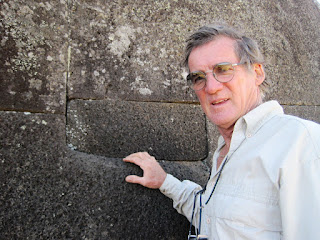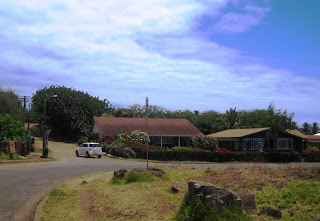At about 15:00, a few officials came down to the boat where certain departure procedures were done.
Once everything was ship-shape, we untied our lines from shore and the concrete jetty as we officially headed out at 16:00 on December 13th (not a Friday!) For exiting the harbout, we were granted permission to use our own waypoints instead of hiring a pilot (I had written down waypoints when we followed the barge in on December 7th). Under sunny skies and warm temperatures, we motored out of the tiny Harbour Piko, with wind on the nose, until we could bear off and rounded the SW end of Easter Island with just a poled head sail.
So long, Easter Island!
We had expected to be running under good wind conditions as long as we could stay away from the high pressure zone on the southern fringe. The strategy was to head south of the rhumb line before turning towards our destination. But the high seemed to overtake us, pushing us further south. We went from good wind the first day to being totally becalmed - we even put out our flopper stoppers to stop the constant rolling as we waited for wind, not wanting to motor so soon on our long passage (expecting about a 21-day voyage). Several days, we only made a direct southing track as we tried to pick up some more winds. A couple of those days were under power to try to escape the calms.
Jordan saw his first great wandering albatross on December 19th. Unfortunately I was sleeping and missed it but we saw more later throughout our passage. They are big birds and look like they fly in slow motion, wingtips flitting along the wave crests, gliding on a cushion of wave wind, barely ever a flap.
Finally on our 7th day out, we had a great day of sailing with a light to medium downwind, running a direct line east to Puerto Montt.
One chilly day, Jordan decided to put on his moccasins as his feet were feeling cold. We both laughed as he hilariously slid from port to starboard continually, unable to stay in one spot with Sea Turtle's heeling. I also dropped 10 eggs, breaking them all. Fun and angst on the high seas.
December 21st is the shortest day of the year up north, but the longest day of the year where we are. It was also a good day sailing with lots of wind, but mostly overcast and some rain. Next day, had one anxious moment when trying to furl the head sail in. The furling drum spun but the sail did not furl in. Thankfully it was only a loose set screw which Jordan quickly tightened.
Easy fix in daylight...
But then a few hours later, we were treated to an outstanding sunset...
Jordan describes the gliding birds:
I love watching these birds about the size of seagulls. They are fast yet hardly ever beat their wings. They streak along the front crest of the swells or waves with wingtips maybe an inch from the water, the peel up about 30 or 40 feet in a fast tight turn and at times almost upside down to make another run at it. They look like fighter pilots making low level bombing runs then peeling up for another strafing.




































